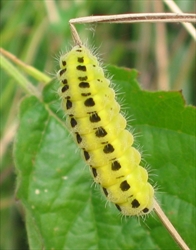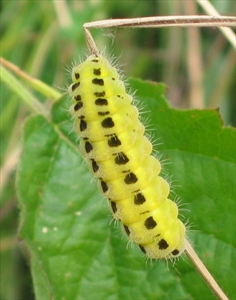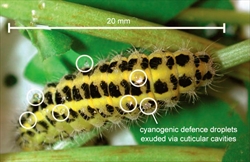Background
The Zygaenidae, known as burnets or foresters, are a world-wide family with over 1000 species with a mainly tropical and Palearctic distribution. In Australia there are 43 species all belonging to the same tribe, the Artonini in the subfamily Procridinae. Both adults and larvae are well-known for their impressive chemical defence using cyanogenic chemicals, and highly aposematic colours and patterns warning potential predators of their distastefulness. The adult moths can release hydrocyanic acid and the caterpillars discharge droplets from stores of defence chemicals in special cuticular cavities in their bodies.
Subfamilies
- Callizygaeninae
- Chalcosiinae
- Procridinae
- Zygaeninae
All New World species are in the subfamily Procridinae.
Short Description
Adapted from Epstein et al. (1999) and Niehuis et al. (2006)
Mature caterpillars are stout, broad and dorsoventrally flattened. However caterpillars from the Callizygaeninae look somewhat different to those in the other subfamilies, resembling more the larvae of the Limacodidae (cup moths). The head is retractile and hidden under the fleshy prothorax. They are often brightly coloured with aposematic patterns to ward off predators (Fig. 1).
Diagnosis
Adapted from Epstein et al. (1999), Niehuis et al. (2006) and Stehr et al. (1987)
- Presence of cuticular cavities for the storage of cyanogenic compounds in most segments (Fig 2). These are internal structures but when disturbed the caterpillars produce defensive droplets arising from the cavities. Present in the Zygaeninae and Chalcosiinae. Secondarily lost in the other subfamilies. This characteristic is believed to be plesiomorphic in the Zygaenidae.
- The thoracic legs have an apical pair of spatulate setae. In Zygaeninae, Chalcosiinae and Procridinae. Also in the Elachistidae.
- Crochets in a uniordinal mesoseries. In Zygaeninae, Chalcosiinae and Procridinae.
- Head retractile (Fig. 1). In Zygaeninae, Chalcosiinae and Procridinae. Similar to the Hesperiidae, but head narrower than T1 in the Zygaenidae, rather than wider in the former family (see Hesperiidae Fact Sheet).
- Integument covered with short, dense spinules. In Zygaeninae, Chalcosiinae and Procridinae.
- Unusual, mouthlike 'gland' near the A2 and A7 spiracles. In the Procrididae.
- 'Gland' at the base of the T1 leg. In the Procridinae.
Detailed Description
Adapted from Epstein et al. (1998) and Niehuis et al. (2006)
The following description applies to the Zygaeninae, Chalcosiinae and Procridinae. Larvae of the Callizygaeninae are similar in shape to those of the Limacodidae (see Limacodidae Fact Sheet), and are brightly coloured and sluggish.
Head: Head capsule usually retracted under the extended prothorax (Fig. 1). The antennae are long. Six stemmata are present.
Body: Integument rough or spinose. The body is covered with dense secondary setae supported by dorsal, lateral and subventral verrucae (Fig. 1). Most segments have two types of internal cuticular cavities for storing cyanogenic chemicals. Both are connected to the exterior through specialised openings. The Procrididae have glands at the base of the T1 leg and near the spiracles on A2 and A7.
Thorax: The legs have an apical pair of spatulate setae of similar size to the claw.
Abdomen: The prolegs are short, with a row of soft basal plates ventral to the crochets. Crochets are arranged in a uniordinal mesoseries.
Species of Biosecurity Concern
THE FOLLOWING SPECIES IS OF BIOSECURITY CONCERN TO NORTHERN AUSTRALIA
Palmartona catoxantha (coconut leaf moth) (Zygaenidae: Procrididae: Artonini)
This species is the only exotic zygaenid that has been recorded in Australia (Queensland, from one record). It is a recognised pest on coconut palms.
Description
Adapted from Tarmann (2005).
The mature caterpillar is slug-like – stout, broad and dorso-ventrally flattened. The ground colour of the body is yellow, but is much paler in early instars. The head is also yellow with dark brown mandibles. The second thoracic segments has a few dark stripes. T3 and the abdominal segments are a more greenish-yellow with a dark violet mid-dorsal stripe and dark lateral stripes.
Diagnosis
From Tarmann (2005).
1. An inflated second thoracic segment (particularly in the early instars).
2. Strong host plant association with palms (Arecaceae)
Other related zygaenids in this tribe (the Artonini), where known, feed on Poaceae (mostly bamboo) and Zingiberaceae (ginger).
Biology and Feeding Damage
Early instars skeletonise leaves whereas the mature larvae eat the edges of leaves causing characteristic holes.
Current Distribution
- Queensland, Australia (from one record)
- Myanmar
- Malaysia
- Singapore
- Indonesia
- The Philippines
- Papua New Guinea
Caterpillar Host Plants
- coconut (Cocos nucifera)
- fan palm (Livistona)
- sago palm (Metroxylon)
- banana (Musa)
- sugar cane (Saccharum) (rarely)
References
Epstein, M.E., Geertsema, H., Naumann, C.M. & Tarmann, G.M., (1999). The Zygaenoidea. In: Kristensen, N.P. (Ed.), Handbook of Zoology. 4(35.1). De Gruyter, Berlin, New York, pp. 159–180.
Jensen N.B., Zagrobelny, M., Hjernø, K., Olsen, C.E., Houghton-Larsen, J., Borch, J., Møller, B.L. & Bak, S. (2011). Convergent evolution in biosynthesis of cyanogenic defence compounds in plants and insects. Nat. Commun. 2:273 DOI: 10.1038/ncomms1271
Niehuis, O., Yen, S. H., Naumann, C. M., Misof, B. (2006). Higher phylogeny of zygaenid moths (Insecta: Lepidoptera) inferred from nuclear and mitochondrial sequence data and the evolution of larval cuticular cavities for chemical defence. Molecular Phylogenetics and Evolution. 39:3:812-829
Stehr, F.W., Martinat, P.J., Davis, D.R., Wagner, D.L., Heppner, J.B., Brown, M.E., Toliver, M.E., Miller, J.Y., Downey, J.C., Harvey, D.J., McFarland, N., Neunzig, H.H., Godfrey, G.L., Habeck, D.H., Appleby, J.E., Jeffords, M., Donahue, J.P., Brown, J.W. & Frack, D.C. (1987) Order Lepidoptera, pp 288–596. In Stehr, F. W. (Ed.), Immature Insects. Kendall/Hunt, Dubuque.
Tarmann, G. M. (2005) A Revision of the Australian Zygaenidae (Procridinae: Artonini). CSIRO Publishing.


